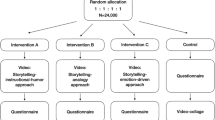Abstract
Multidisciplinary self-management programs are important in inflammatory arthritis as adjunctive treatment. Patients often have excuses as to why they do not attend these programs. The purpose of this study was to determine whether an intervention of televised testimonials from rheumatologists and allied health professionals increases attendance at a multidisciplinary education day for rheumatology patients seen in a large university hospital clinic. This was an RCT of intervention: playing televised interviews in the waiting room where rheumatology patients were seen versus no TV. There was a total of 6 months (3 months with and 3 without the televised interview playing). All eligible patients who attended the rheumatology outpatient clinic were then tracked to determine whether they attended a subsequent education day over the next 10 months. The sample size was calculated to have a 15 % increase in attendance at the education days. There was a 20 % increase in attendees at the multidisciplinary education days for patients who saw the televised testimonials. Sixty-three patients who viewed the testimonials (2.17 % of 2,908) attended the education day compared to 39 who did not receive the intervention (1.80 % of 2,168); however, the increase was not statistically significant (p = 0.36). Attendance of eligible patients increased using televised testimonials; however, the increase was not significant as the rates of attendance were still very low in both groups. Many eligible patients did not attend the program. Other interventions are necessary to encourage attendance in a multidisciplinary program.
Similar content being viewed by others
References
Bojke L, Spackman E, Hinde S, Helliwell P (2012) Capturing all of the costs in NICE appraisals: the impact of inflammatory rheumatic diseases on productivity. Rheumatology 51(2):210–215
Zhang W, Anis AH (2011) The economic burden of rheumatoid arthritis: beyond health care costs. Clin Rheumatol 30(Suppl 1):S25–S32. doi:10.1007/s10067-010-1637-6
Vlieland TPV, Li LC, MacKay C, Bombardier C, Bradley EM (2006) Current topics on models of care in the management of inflammatory arthritis. J Rheumatol 33(9):1900–1903
Meesters J, Hagel S, Klokkerud M, Stovgaard I, Bremander A, Grotle M, Hørslev-Petersen K, Petersson IF, Hagen KB, Pont W, Vlieland TV (2013) Goal-setting in multidisciplinary team care for patients with rheumatoid arthritis: an international multi-center evaluation of the contents using the international classification of functioning, disability and health as a reference. J Rehabil Med 45(9):888–899. doi:10.2340/16501977-1191
Meesters J, Verhoef J, Tijhuis G, Vliet Vlieland T (2013) Functional disability in patients with rheumatoid arthritis admitted for multidisciplinary rehabilitation from 1992 to 2009. Rheumatology (Oxford) 52(10):1879–1883. doi:10.1093/rheumatology/ket232
Scholten C, Brodowicz T, Graninger W, Gardavsky I, Pils K, Peseau B et al (1999) Persistent functional and social benefit 5 years after a multidisciplinary arthritis training program. Arch Phys Med Rehabil 80(10):1282–1287
Petersson IF (2005) Evolution of team care and evaluation of effectiveness. Curr Opin Rheumatol 17(2):160–163
Taal E, Rasker JJ, Wiegman O (1996) Patient education and self-management in the rheumatic diseases: a self-efficacy approach. Arthritis Care Res 9(3):229–238
Warsi A, LaValley MP, Wang PS, Avorn J, Solomon DH (2003) Arthritis self-management education programs: a meta-analysis of the effect on pain and disability. Arthritis Rheum 48(8):2207–2213
Giraudet-Le Quintrec JS, Mayoux-Benhamou A, Ravaud P, Champion K, Dernis E, Zerkak D et al (2007) Effect of a collective educational program for patients with rheumatoid arthritis: a prospective 12-month randomized controlled trial. J Rheumatol 34(8):1684–1691
Niedermann K, Fransen J, Knols R, Uebelhard D (2004) Gap between short-and long-term effects of patient education in rheumatoid arthritis patients: a systematic review. Arthritis Rheum 51(3):388–398
Koehn CL, Esdaile JM (2008) Patient education and self-management of musculoskeletal diseases. Best Pract Res Clin Rheumatol 22(3):395–405
Wheeler JG, Fair M, Simpson PM, Rowlands LA, Aitken ME, Jacobs RF (2001) Impact of a waiting room videotape message on parent attitudes toward pediatric antibiotic use. Pediatrics 108(3):591–596
Oermann MH, Webb SA, Ashare JA (2003) Outcomes of videotape instruction in clinic waiting area. Orthop Nurs 22(2):102–105
Graziani C, Rosenthal MP, Diamond JJ (1999) Diabetes education program use and patient-perceived barriers to attendance. Fam Med 31(5):358–363
Eubelen C, Brendel F, Belche JL, Freyens A, Vanbelle S, Giet D (2011) Effect of an audiovisual message for tetanus booster vaccination broadcast in the waiting room. BMC Fam Pract 12:104
Acknowledgments
This work was supported by a grant from Canadians for Improved Outcomes in Rheumatology Care (CIORA), which is administered by the Canadian Rheumatology Association (CRA).
Conflict of interest
There are no conflict of interests to declare.
Ethical standard
Ethics approval was obtained from the Western University Ethics Board.
Author information
Authors and Affiliations
Corresponding author
Rights and permissions
About this article
Cite this article
Tingey, P., Khanafer, M., Singh, K. et al. Social persuasion in rheumatology: a randomized trial of testimonials on television in the rheumatology clinic waiting room to increase attendance for multidisciplinary education. Rheumatol Int 34, 903–907 (2014). https://doi.org/10.1007/s00296-014-2961-y
Received:
Accepted:
Published:
Issue Date:
DOI: https://doi.org/10.1007/s00296-014-2961-y




